
Exploring Malcolm X
Malcolm X (May 19, 1925 - February 21, 1965)
Malcolm X, born Malcolm Little was an influential African American Civil Rights leader, activist and minister. Known for his strong advocacy for black empowerment and his critique of racial injustice. Malcolm X was born in Omaha, Nebraska later on moving to Michigan. From a young age Malcolm lived through racism, dealing with most of his uncles and father dying due to racism, even having multiple confrontations with the Ku Klux Klan (KKK). Malcolm used his confrontations with racism and the Islamic religion to start advocating for Civil Rights. He was known for his aggressive, more violent take on social justice and told African Americans to stand their ground against racism.
Malcolm X in America

3448 Pinkney Street Omaha, Nebraska now part of the U.S. National Park Service
This is the site of where Malcolm Little was born in Omaha, Nebraska. In Malcolms early years he dealt with racism. The KKK visited his house and broke windows and shouted at Malcolms family. Malcolm would later use this and other situations to fuel his advocacy for Social Justice.

Malcolm X's mug shot after being arrested in Massachusetts
Malcolm went to jail in Norfolk Prison Colony, Massachusetts. This ended up changing his life were he learned to study Islam and learn his views on the Civil Rights Movement. He committed crimes such as gambling, selling drugs and burglary.

Image of Harlem
Malcolm X lived in Harlem in 1943. While living in Harlem Malcolm focused on preaching the Islamic religion. He would later set up Temple number 7 where he was the head Minister and preached Islam. Harlem was a big factor in Malcolms life.
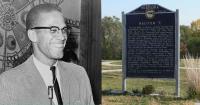
Malcolm X Home town
Malcolm was born in Omaha, Nebraska. The populations majority was Caucasians and African Americans. Early in the 20th century African Americans started migrating into Nebraska. The town was racist with the KKK being in Nebraska. The city was also dangerous, there where many crimes such as shootings.
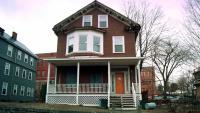
Boston
In 1941 Malcolm lived in Boston, Massachusetts. At the time Boston had a large Irish and African population. Here in Boston Malcolm learned about the Nation of Islam. The Nation of Islam is a black nationalist religion, and an African-American religion. Although Elijah Muhammad the leader of the NOI wasn't in Boston the practice spread to many cities.
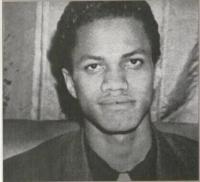
Detroit
Detroit was another important city Malcolm lived in. At the time Detroit was a growing African American community. Segregation was still a big factor in Detroit at the time. Music, such as Jazz, also played a role in Detroit. Detroit was also the central point of the NOI.
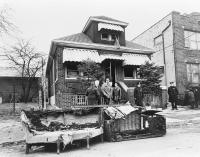
Harlem
Harlem was a predominantly African community. Harlem has a deep history of African culture. Examples of this are music and art. The Islamic religion was also important in Harlem. Harlem was a very comfortable place for Africans to live at in the 20th century.
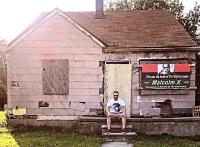
Inkster, Michigan
Michigan at the time when Malcolm lived there was predominately white and African Americans. There was some problems with race and segregation in Michigan before Malcolm lived there. Music also had a big role in Michigan before Malcolm lived there, with large crowds for African musicians playing. Many Africans migrated to Lansing, Michigan in the 20th century. By 1920 there were 109,594 African Americans in Chicago.
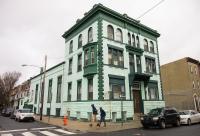
Philadelphia
Philadelphia, like many other cities at the time was going through racial troubles. Philadelphia started to have a growing population of African Americans in the 1950s-1960s. North Philadelphia was predominately African Americans. Overtime this became a hub for the African Civil Rights Movement. Philadelphia was an important city in the North for Africans.
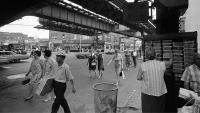
Queens
Post war, in the 1960's, Queens starting having a rapid growth in population. Queens was also rich with diversity including, White, Africans, Hispanics and Italians. Queens was also known for its music especially Jazz. Queens was a big community that was a big place for people to life unified together.

Atlanta
Atlanta, in the 1960s, was one of the largest African cities in America. Georgia at the time had legally enforced segregation. This included segregation in schools. A famous court case, Calhoun vs Latimer came up because of this. The state of Georgia along with the US was in a deep battle against racism.
Malcolm X lived in America at a time of racial tensions, economic hardships and Wars. Malcolm lived through many racial situations which and at the time the KKK was rising. During the 1930's- 1940's the US was going through the Great Depression causing many people to lose their jobs and become homeless. Malcolm also lived during two Wars. He lived through World War Two which the United States fought in. He also lived during the Cold War, which is when US and the USSR was battle between Communism and Democracy.
Malcolm started his life out in the Americas and ended it there. These areas in America effected Malcolms view on Civil Rights. In America Malcolm joined the Nation of Islam and grew a stance of Africans fighting for their rights. He made Temples all over America and preached at them too. He gave speeches and learned from people in America to fight for the rights of Africans. Malcolms impact he made in America and what he taught helped change the movement to make Civil justice equal.
Malcolm X Out Of America
Malcolm X went to visit many places outside of the Americas. He visited places in parts of Europe and parts of Africa. Malcolm even went on a Hajj (Islamic pilgrimage to Mecca, Saudi Arabia) while in Mecca, because of the unity of various ethnic backgrounds, Malcolms views on the Civil Rights Movement changed drastically making him have a more friendly approach to the movement. Malcolm gave speeches in other places in Europe and was a key role in many of smaller countries unity.
Malcolm X in London
Malcolm X visited London in 1964, in London he met with various African and Caribbean intellectuals, Civil Rights activists, and members of the African diaspora. These people include; C.L.R. James, Stokely Carmichael (later known as Kwame Ture), Ali Mazrui and Kwame Nkrumah's representatives. Malcolm drew a large crowd in London, speaking about the struggle for racial justice and self- determination. He spoke about Black Nationalism and Self-Defense, Separation vs. Integration and Global Solidarity and Pan-Africanism.
Malcolm X in Paris, France
Malcolms trip to Paris in 1965 was important as well. Europe was important because after interacting with African and Caribbean expatriates such as Ghanaian diplomat and scholar, Dr. George Padmore and Manning Marable, a Trinidadian intellectual and activist who later wrote extensively about Malcolm's life and legacy, he broaden his view of African identity and the importance of Pan-African unity. His time in Paris also deepened his understanding of the role of European powers in the exploitation of African nations.
Malcolm X in Moscow, Russia
While in Moscow Malcolm met with Soviet officials and gained insight into their views on race and colonialism, which contrasted sharply with the U.S. government’s policies. This is important because the US was at the time of the Cold War with the USSR. Malcolms visit allowed him to get a perspective of both sides.
Outside of the Americas many things where going on such as, Europe was going through Economic struggles, World War Two and the Cold War, and Colonization in Africa. After WW1 Europe was going through Economic struggles until 1939. WW2 and the Cold War caused the world to split between Democracy and Communism. And African colonies began to leave rule of European countries. The whole world was going through many different problems from the time of 1925-1965.
Malcolm X's impact extended far beyond the United States, inspiring movements for racial justice and decolonization across Europe and Africa. His critiques of colonialism and imperialism resonated with oppressed peoples worldwide, particularly in post-colonial nations struggling for independence. His journey to Mecca and subsequent shift in worldview also connected him to global struggles for human rights, further broadening his influence. His travels to these parts of the world made an impact on what he should teach and how people should fight for their Civil Justice.
Malcolms connection with other influential people
Malcolm X and MLK Jr. standing together
The relationship between Malcolm X and MLK Jr. was at first complicated. The two had differing views on racial justice. Malcolms being more aggressive then MLK. Over time, particularly after Malcolm's pilgrimage to Mecca, his views began to shift, and he expressed more openness to dialogue and collaboration with other Civil Rights leaders, including King.
Malcolm X and MLK in Ghana together
Malcolm X and Maya Angelou shared a deep mutual respect, though their relationship was not without complexities. Angelou admired Malcolm's courage and powerful voice in advocating for Black liberation, often recalling how his speeches inspired her. While they met on several occasions, Angelou initially felt conflicted about his more militant stance, especially as she was more focused on unity and peaceful change.
Explore the strong friendship between Maya Angelou and Malcolm X in Ghana
Bibliography
Allen, David Grayson. “The Rise of Venture Capital in Postwar Boston.” Investment Management in Boston: A History, University of Massachusetts Press, 2015, pp. 169–91. JSTOR, http://www.jstor.org/stable/j.ctt1cx3t54.11. Accessed 13 Nov. 2024.
SITKOFF, HARVARD. “The Detroit Race Riot of 1943.” Toward Freedom Land: The Long Struggle for Racial Equality in America, University Press of Kentucky, 2010, pp. 43–64. JSTOR, http://www.jstor.org/stable/j.ctt2jcgvk.7. Accessed 13 Nov. 2024.
FERNÁNDEZ, JOHANNA. “COMING OF AGE IN THE 1960S: The Emergence of the New York Young Lords.” The Young Lords: A Radical History, University of North Carolina Press, 2020, pp. 49–90. JSTOR, http://www.jstor.org/stable/10.5149/9781469653464_fernandez.5. Accessed 13 Nov. 2024.
X, Malcolm, and Alex Haley. The autobiography of Malcolm X. New York City, New York: Random House Publishing Groups, 1964.
Cartwright, Marguerite. “GHANA: INDEPENDENCE WITHIN THE COMMONWEALTH.” Negro History Bulletin 23, no. 1 (1959): 3–4. http://www.jstor.org/stable/44213347 .
Collins, Carole. “Colonialism and Class Struggle in Sudan.” MERIP Reports, no. 46 (1976): 3–20. https://doi.org/10.2307/3010898 .
Awa, E. O. “FEDERAL ELECTIONS IN NIGERIA, 1959.” The Indian Journal of Political Science 21, no. 2 (1960): 101–13. http://www.jstor.org/stable/41853826 .
Walton, Thomas. “Economic Development and Revolutionary Upheavals in Iran.” Cambridge Journal of Economics 4, no. 3 (1980): 271–92. http://www.jstor.org/stable/23596549 .
Johnson, Peter. “Egypt Under Nasser.” MERIP Reports, no. 10 (1972): 3–14. https://doi.org/10.2307/3011223 . -
American Masters PBS, Youtube video, https://www.youtube.com/watch?v=uBnlfPayXpw&t=1s .
Jean Hutson Blackwell, “Harlem: A Cultural History. Selected Bibliography.” The Metropolitan Museum of Art Bulletin 27, no. 5 (1969): 280–88. http://www.jstor.org/stable/3258420.
Victoria W Wolcott, “Defending the Home: Ossian Sweet and the Struggle against Segregation in 1920s Detroit.” OAH Magazine of History 7, no. 4 (1993): 23–27. http://www.jstor.org/stable/25162908.
Clare V McKanna,“Seeds of Destruction: Homicide, Race, and Justice in Omaha, 1880-1920.” Journal of American Ethnic History 14, no. 1 (1994): 65–90. http://www.jstor.org/stable/27501934.
Timothy J Meagher, “Sweet Good Mothers and Young Women out in the World: The Roles of Irish American Women in Late Nineteenth and Early Twentieth Century Worcester, Massachusetts.” U.S. Catholic Historian 5, no. 3/4 (1986): 325–44. http://www.jstor.org/stable/25153768.
Amy Absher, “Musicians and the Segregated City: Chicago in the Early 1900s-1930s.” In The Black Musician and the White City: Race and Music in Chicago, 1900-1967, 16–47. University of Michigan Press, 2014. https://doi.org/10.2307/j.ctv3znzb4.5.
Alton Hornsby, “Black Public Education in Atlanta, Georgia, 1954-1973: From Segregation to Segregation.” The Journal of Negro History 76, no. 1/4 (1991): 21–47. http://www.jstor.org/stable/2717407.